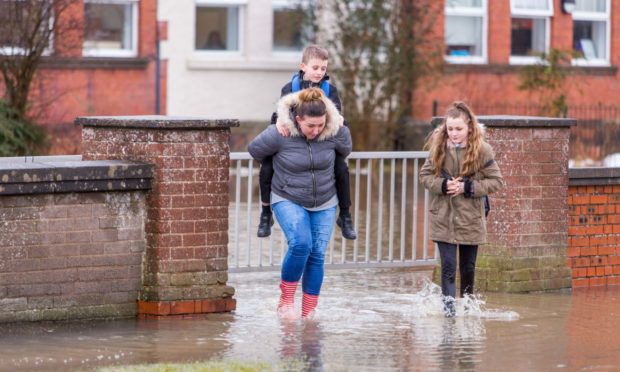Flooding. From surface water making driving conditions tricky to floodwaters causing life-threatening structural damage, it’s never welcome.
But it is something we are likely to see a lot more of.
In our next article focusing on flooding, we will be looking at how flash floods are becoming a dreaded yearly expectation for communities.
But this time the focus is on our changing climate.
This summer has already seen flooding in parts of Tayside and Fife.
And who can forget last year’s exceptional rainfall and flash floods of August 11 and 12 as thunderstorms relentlessly battered Scotland.
The impact of those storms was catastrophic.
Heavy rainfall was found to have contributed to a train derailment near Stonehaven, which claimed the lives of three people.
The downpours also flooded nearly 200 homes across Perth and Kinross, caused a landslide at a caravan park, and left NHS staff with their cars under water.
The Scottish Environment Protection Agency’s report into the August storms described them as an “extreme event” and the likelihood of a recurrence “rare”.
But as the mercury soared during the recent heatwave, there was a fear it could happen again.
Are we now living with the threat of flash floods every year?
Wetter and warmer weather makes flash floods every year more likely
The Met Office recently delivered some stark warnings in its latest State of the UK Climate report.
It clearly states: “The UK’s climate is changing.”
Here are some of the report’s findings:
- Six of the 10 wettest years the UK has seen since 1862 have occurred since 1998.
- Last year was the UK’s third warmest, fifth wettest and eight sunniest on record.
- The UK’s top 10 warmest years since 1884 have occurred since 2002.
- February 2020 was the UK’s wettest February and fourth wettest calendar month on record since 1862.
- February 15 and October 3, 2020, were two of the wettest days UK-wide since 1891.
- Ten named storms affected the UK in 2020.
What does climate change mean for me?
Scientists are generally in agreement that as our climate changes, the Arctic is warming up.
As the climate warms up, sea levels are rising.
A warmer atmosphere also increases the ability of the air to hold moisture. And what goes up must come down – in the form of torrential downpours.
Warming also affects the jet stream – a current of powerful winds high up in the atmosphere that governs our weather.
Arctic warming can cause the jet stream to get stuck in one place.
On the ground, that means if it’s dry and sunny it will stay dry and sunny for a while. And if there is wet, rainy weather, it will also persist.
It is not good news.
It is thought the jet stream could have contributed to the recent fatal floods in Europe.
And more extremes of weather will inevitably bring more flash floods.
It is reasonable to assume these will happen every year. The challenge is predicting which communities will be affected next.
